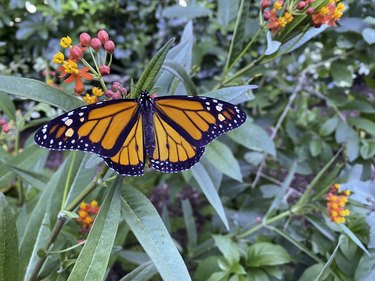
Gathering a few butterfly eggs from the garden is a learning experience for both children and adults. While you can buy a butterfly hatching kit, making your own egg and caterpillar habitat using recycled containers and a bit of cheesecloth or netting is a budget-friendly option. Most butterfly eggs hatch in just a few days depending on the species and then you can move on to caring for the caterpillars and eventually watch the full-grown butterflies emerge from their cocoons.
Gathering Butterfly Eggs and Food
Video of the Day
Butterfly eggs are usually found on the green leaves of the caterpillar's favorite food. For example, monarch butterfly caterpillars only feed on milkweed leaves. Some butterflies lay one egg, while others lay clusters of eggs, usually on the bottom of the leaf or a nearby stem.
Video of the Day
Search for the butterfly eggs in spring and early summer by turning over the leaves and looking at the underside. You may wonder, "What color are butterfly eggs?" The tiny 1- to 3-millimeter eggs may be white, cream, yellow, orange, green or other colors and round or oblong. Don't try to remove single eggs or clusters of eggs from the leaf; instead, snip the entire leaf and its stem from the plant, eggs and all.
Caring for Butterfly Eggs
A clear, recycled plastic container with a lid is a suitable container for the leaf and egg. Wrap the stem of the leaf in a damp paper towel to keep it green and healthy. Place it in bright, filtered light or if the parent plant was growing in dappled or full shade, place the container in similar lighting. Keep it in a warm but not hot location.
Mist the leaf lightly if necessary to keep it moist but not water-soaked. Don't let it dry out, as the egg needs to stay moist, or the larva will die. Butterfly egg hatching time varies from one to 14 days, though the eggs of some species that overwinter in tree bark or plant debris may take longer for the larvae to develop.
Feeding Butterfly Caterpillars
After a caterpillar emerges from its egg, it needs a constant supply of fresh leaves to thrive. Some species eat the remnants of their eggs first and then move on to the leaves. As the caterpillar grows, it will shed its skin, or molt, several times over the nine to 16 days or more before it disappears into its cocoon or chrysalis. It may also change colors and markings with each molt.
Harvest fresh green leaves on the stems from the plant where you found the egg. Add new stems with leaves to the container daily and remove old, shriveling and dead leaves.
Don't disturb the caterpillar when it is molting. As it grows, move it into a larger container, aquarium or "critter carrier" so it has room to grow. After the butterfly emerges, it needs enough space to spread its wings. Cover the top of a jar with cheesecloth or mesh and secure it with a rubber band.
Setting Your Butterflies Free
The metamorphosis of a caterpillar to a butterfly takes approximately one to two weeks. The butterfly will emerge from the cocoon, clinging to the stick or leaf and slowly extending and flapping its wet wings. After about two hours, its wings will be dry, and it's time for the butterfly to flutter away.
Take the container and butterfly outside and remove the top. Give the butterfly time to acclimate to the outdoors and soon it will fly away to begin the cycle again.